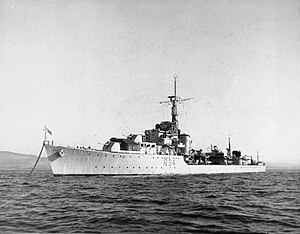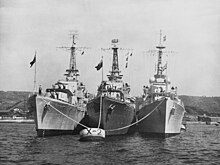HMS Cockade (R34)

| |
| History | |
|---|---|
| Name | HMS Cockade |
| Builder | Yarrow Shipbuilders |
| Laid down | 11 March 1943 |
| Launched | 1 March 1944 |
| Commissioned | 29 September 1945 |
| Decommissioned | 1958 |
| Identification | Pennant number: R34 later changed to D34 |
| Status | Arrived at Cashmore, Newport July 1964 for breaking |
| General characteristics | |
| Class and type | Template:Sclass2- destroyer |
| Displacement |
|
| Length | 362.75 ft (110.57 m) o/a |
| Beam | 35.75 ft (10.90 m) |
| Draught | 11.75 ft (3.58 m) |
| Propulsion |
|
| Speed | 36 knots (67 km/h) / 32 knots (59 km/h) full |
| Range |
|
| Complement | 186 |
| Sensors and processing systems | Radar Type 275 fire control on director Mk.VI |
| Armament |
|
HMS Cockade was a Template:Sclass2- destroyer of the Royal Navy. A cockade is a knot of ribbons, or other circular- or oval-shaped symbol of distinctive colours which is usually worn on a hat. So far she has been the only ship of the Royal Navy to bear the name.
Cockade was launched on 1 March 1944 and commissioned on 29 September 1945.
Service


Cockade commissioned too late to see service in the Second World War. After the war she was allocated the pennant number D34. Her first commanding officer was Lt Cdr Terence Desmond Herrick, DSC RN. She served in the post-war Royal Navy, initially sailing to the Far East, exercising off Hong Kong in 1946. She subsequently saw service in the Korean War, acting as escorts for the Royal Navy aircraft carriers and providing shore bombardment capability.[1] Whilst there she also visited Singapore and Japan.
In early 1957, Cockade took part in the Malayan Emergency as part of the 8th Destroyer Squadron. On 26 April, during night exercises, a star shell fired by Cockade landed in a gun bay on the Australian destroyer HMAS Tobruk, killing one seaman and severely wounding another.[2] Later in 1957 Cockade was stationed at Hong Kong.
Decommissioning and disposal
Cockade returned to Plymouth from the Far East in 1958 and decommissioned for the last time. The destroyer was laid up at Devonport in reserve pending disposal. Following her decommissioning Cockade was sold in September 1964 to John Cashmore Ltd for breaking up at Newport, Wales.[3]
References
- ^ Marriott, Leo (1983). Royal Navy Frigates 1945-1983. Ian Allen Ltd. pp. 65–6.
- ^ Cassells, Vic (2000). The Destroyers: Their Battles and Their Badges. East Roseville, NSW, Australia: Simon & Schuster, pp. 137, 240.
- ^ Critchley, Mike (1982). British Warships Since 1945: Part 3: Destroyers. Liskeard, UK: Maritime Books. p. 100. ISBN 0-9506323-9-2.
Publications
- Colledge, J. J.; Warlow, Ben (2006) [1969]. Ships of the Royal Navy: The Complete Record of all Fighting Ships of the Royal Navy (Rev. ed.). London: Chatham Publishing. ISBN 978-1-86176-281-8.
- Marriott, Leo (1989). Royal Navy Destroyers Since 1945. Ian Allen Ltd. ISBN 0-7110-1817-0.
